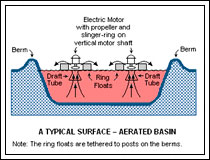Surface Aerated Basins
Aerated Basin, also known as lagoon, refers to a man made pond which is used for water treatment by promoting biological oxidation of the waste water through artificial aeration. In these aerated basins, oxygen (or air) and microbial action are utilized to bio-treat the pollutants in the wastewater. There are many other biological processes of wastewater treatment that functions using oxygen and microbial action. A few examples are like activated sludge, trickling filters, rotating biological contactors and bio-filters. An aerated basin acts as a biologically assisted flocculator and converts the soluble biodegradable organics of the influent to a biomass which settles down as sludge. The effluent can then be removed from the top with a low Chemical Oxygen Demand, while the sludge accumulated on the floor undergoes anaerobic stabilization.

For artificially aerating these ponds or basins, various methods are used. A few of them are:
- Motor-driven floating surface aerators
- Motor-driven submerged aerators
- Motor-driven fixed-in-place surface aerators
- Injection of compressed air through submerged diffusers
Surface Aerated Basins
Basins using Motor-driven floating surface aerators are known as Surface AerATED Basins or Lagoons. In basins or ponds using floating surface aerators, 80 to 90% of Biological Oxygen Demand (BOD) removal can be attained. Usually the sludge is retained in these basins for 1 to 10 days. These basins are built with a depth ranging from 1.5 to 5.0 meters. Using a surface aerator, air required for the biologicaloxidation, is transferred into these basins, then the same surface aerators facilitates the mixing of the reactants, that is, oxygen, wastewater and microbes. This mixing allows the dispersion of the air. A typical floating surface aerators delivers an amount of air equivalent to 1.8 to 2.7 kg O2/kWh. But in surface aerated basins, very good mixing can't be attained as it is achieved in case of activated sludge systems; therefore aerated basins do not deliver the same performance as activated sludge units do. An operating temperature of 4 °C and 32 °C is maintained in these basins in order to have a proper biological oxidation processes, which being temperature sensitive, increases with temperature.
|